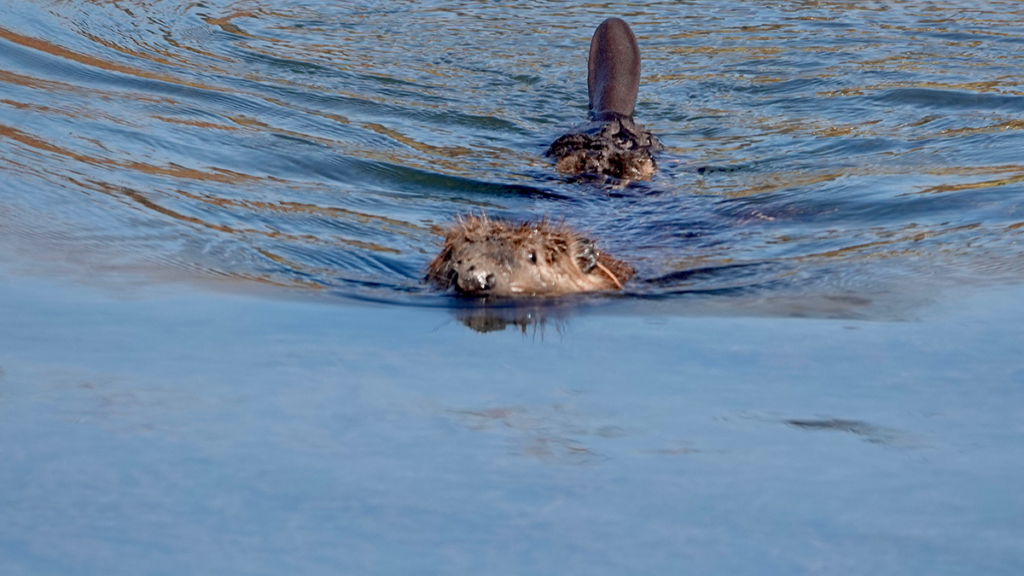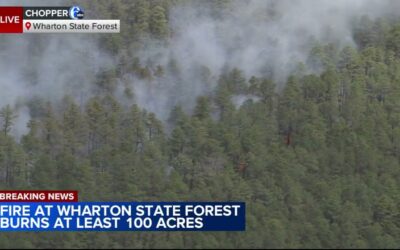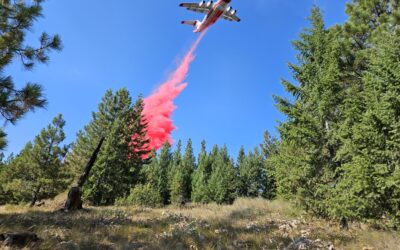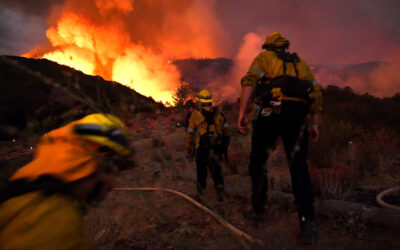
The baby beaver kit hitching a ride on the tail of its older [subadult]
sibling so that it can join the rest of the family in exploring their new habitat. (OAEC Photo/Brock Dolman)
So, what’s the best way to replicate those benefits? The California Department of Fish and Wildlife has set out to repopulate remote areas with the large-tailed rodents. So far, the plan appears to be working.
Fish and Wildlife has launched the first portion of its beaver translocation program, conducting the first conservation release of the animals in approximately 75 years. The release of seven family members took place in mid-October in Humbug Valley, south of Chester, in Plumas County, in conjunction with the Native American group Maidu Summit Consortium.
The new family group of beavers joins a single resident beaver in the valley with the objective of re-establishing a breeding population that will maintain the mountain meadow ecosystem, its processes and the habitat it provides for numerous other species.
“We wanted to get them established, and to make sure they had time to settle into area,” said Fish and Wildlife biologist Valerie Cook, who helped conduct the relocation.
Things have gone well, Cook said: “There have been no disturbances that have caused them to abandon the release site. Everybody has survived and looks good.”
California’s legislature provided funding for Fish and Wildlife to conduct the project. Beaver restoration is now part of the state’s larger effort to help mitigate the impacts of wildfires, climate change and drought.
“Beavers help retain water on the landscape, which increases groundwater recharge, improves summer baseflows, extends seasonal flows and increases fuel moisture during wildfire season, effectively creating green belts that can serve as wildfire buffers or breaks and provide refuge for wildlife,” said Charlton Bonham, Fish and Wildlife’s director.
The release represents the first phase of Fish and Wildlife’s North American beaver restoration project, releasing beavers into the waters on the ancestral lands of the Mountain Maidu people. The department plans to duplicate the relocation efforts on the Tule River Reservation in the southern Sierra Nevada range in spring 2024.
For now, though, Cook said she and other biologists are pleased with the results of October’s release.
“I anticipate we’ll bring in another family group to bring in more genetics,” she explained. “It’s a big habitat to restore. We’ll have to see how this family group does through the winter.”
Cook said her department uses a variety of monitoring methods to see how the beavers get along.
“We also have transmitters and radio telemetry and GPS (global positioning system) transmitters on them,” she said.
“Since this is California’s first beaver release, we’re learning as we go,” Cook said. “We’re making some assumptions and plan on being adaptive. Our objective is to have an established population. We’ll need to see what reproduction and survival looks like.”
In alignment with Fish and Wildlife’s new beaver depredation policy, the family was relocated from Sutter County, where their activity was damaging lands supporting several threatened or endangered species.
To date, the entire family group, which consists of a breeding pair and their offspring, has survived. After exploring miles of habitat throughout the valley and locating the resident beaver’s territory, the family settled into the release area and has established shelter for the impending winter.
Officials will monitor the relocated beavers and the Plumas County ecosystems for the next several years to assess the population, movement, habitat utilization, behavior and activity, potential conflicts, mortality (if any) and the need for additional relocations. Officials will also watch the ecological changes that result from beaver engineering on the landscape.
October’s release capped a yearslong effort to prepare the release site to ensure adequate beaver habitat that offers protection from predators and can support beaver population establishment. A collaboration between the Maidu Summit Consortium and the U.S. Fish and Wildlife Service, Occidental Arts and Ecology Center’s WATER Institute, Lassen National Forest, Plumas Corporation, Swift Water Design, Symbiotic Restoration, Feather River Land Trust, the Sierra Fund, Cal PBR Network and several others.
___
(c)2023 Chico Enterprise-Record, Calif
Visit Chico Enterprise-Record, Calif at www.chicoer.com
Distributed by Tribune Content Agency, LLC.




